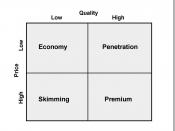Article Main Points Summary
The "Flanking in a Price War" article describes a study conducted in the 1980's testing the pattern of price sensitivity for stock-up grocery goods (products that can be stockpiled) and nonstock-up grocery goods (perishables that can not be stockpiled) in the Quebec grocery market. A covariance design within a Bayesian decision framework was used and provided an indicator as a stop rule for the study. The results of the study were used to strategically price items to increase market share. The results indicated in an oligopoly, competitive reaction is swift and a sustainable competitive advantage requires more than engaging in price war strategies.
The study was devised at the request of a struggling grocer chain, IGA, in the Quebec Grocery Oligopoly during the 1980's. The results of this experiment provided the management of IGA with a sound pricing, or flanking strategy that could be, and successfully was, implemented to rebuff the threats initiated by a price war.
It was shown that the strategy actually had a beneficial impact on the chain while others, including the price war initiator, struggled to maintain market share. This was a great example of oligopoly competition where large and small grocery chains aggressively competed with one another by lowering prices and engaging in "price wars" only to see one grocery chain emerging as the price leader at the expense of reduced gross margins.
The article describes the reaction of competitors to pricing moves that went beyond a pure pricing strategy. It discusses how advertising contributed to harden price sensitivity and the use of other tactics such as increased customer service, which in the grocer industry has little marginal effect when it serves as the only differential variable between competing grocery chains.
Lastly, this article highlights the strength of collaboration and...


